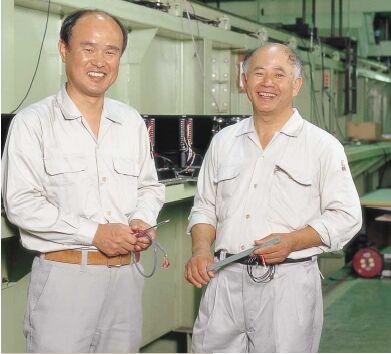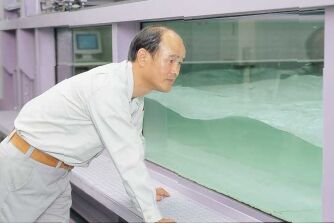 |
 |
| Mr. Michiyoshi Ishibashi (left) and Mr. Kenji Marubayashi (right) | The Sea Observation Station off Tsuyazaki |
The education and research activities of Kyushu University are supported by many people, one group of which is Gikan (Technical Officials), staff who assist with the research conducted in laboratories. Working at the Research Institute for Applied Mechanics, Mr. Kenji Marubayashi and Mr. Michiyoshi Ishibashi are two of these officials.
Mr. Michiyoshi Ishibashi (left) and Mr. Kenji Marubayashi (right) The Sea Observation Station off Tsuyazaki
Marubayashi: Our work is to conduct research related to ocean physics, which is the research field of Professor Masuda, Dean of Dynamics Simulation Research Center. Professor Masuda says the research should be conducted with the combined efforts of three factors: observation, theory and experiment. We are engaged in two of them, observation and experiment. The recent large project was the establishment of ocean radar at Tsushima Island.
Marubayashi: Tsushima was chosen because Nihon-kai (Japan Sea) is not affected by the open sea very much and its size is suitable for observation. Another good point of Nihon-kai is that it has the characteristics of an ocean. Therefore the island is perfectly suited for observing the relationship between the ocean and climate change. Usually when we conduct experiments outside our laboratory, we only do the mechanical work, however, in Tsushima, we had to start with looking for a space to build the radar like a real estate agent.
Ishibashi: Tsushima is a really mountainousisland.
Marubayashi: We had a hard time findingland for our radar. Now I can say this hardship was one of our good memories, though.
Ishibashi: The data measured by the radar is transferred to the computer in this room. Any control can be done through the computer, so this room is the control tower. If any malfunction occurs, we fly to Tsushima. Since I always think about waves of the sea, I couldn't help building my house by the sea where I can survey the waves any time.
Marubayashi: (showing the data below) As you can see, the lines of the sea current moving through the Tsushima Strait are shown hourly. Precisely measured data of tides like those can be used for research forever.
Data measured in 1999
Marubayashi: Yes, both of us are electric officials. However now I am in charge of mechanical parts like metalwork, and Ishibashi is in charge of software. You will understand our responsibilities through the Wind-Wave Simulation Facility, for example. (We moved to another workshop where the tank is located. It is more than 60 meters long and artificial waves and wind can be made and observed.) I was in charge of design and assembly, and Ishibashi was in charge of the automatic measuring system and controlling the waves and wind.

Ishibashi: For the observation, we use a wave-height measuring instrument that measures the wave height using electricity. Marubayashi was in charge of the mechanical part of this instrument and I was in charge of the electric circuit and computer control. This tank is driven by an automated measuring system we made. Since we built this whole system, its repair is easy for us. It seldom gets out of control, though.
Marubayashi: I've been interested in developing a sensor used to show a phenomenon through electric signals. If we are successful in developing the sensor, our research will go forward. There is a dream of finding a way to see what we cannot actually see.
Marubayashi: Outsourcing the equipment is one of the choices we can make; however, it takes time to make the equipment and it is difficult to pass on the subtle adjustments. It is more interesting than difficult to create something new that hasn't existed. We always want to be the first.
Ishibashi: Making a new machine gives us experience.
Marubayashi: Through this experience, we have an idea of how much a machine should cost when we give an order to an outside company. Also based on this experience, we can improve the machine. (We moved to another room where the "coast and continental shelf environment experiment tank" is located. This tank can easily produce vertical and horizontal waves and storm level wind).
Marubayashi: The tank we showed you before produces 2-dimensional waves, but this one, which produces 3-dimensional waves, was made using all of our knowledge. This wave absorbing system has a lot of refinements. We are confident that no one can do better than we in starting, measuring and absorbing a wave. We believe we are the best in the world. I don't want to frustrate everyone's efforts through not receiving precise data because of my ignorance of careful preparation.
Marubayashi: Of course we do anything as far as we can. But if there is a difficulty in carrying out work, we don't immediately say "Yes." We think about it for a while and if it is possible, then we say "Yes" at the end. Our duty is to support technical aspects of our professor's research. We want Professor Masuda to concentrate on his research. We don't want him to waste his precious time with technical work and miscellaneous business. We are expecting him to write a great thesis recognized by the world in the near future.
Ishibashi: There are several research themes in our laboratory. The biggest and the one that takes precedence is the Sea Observation Station, which is offshore from Tsuyazaki, Fukuoka. Observation of the ocean depends on the weather, and summer is the only time we can do this research.
Marubayashi: Only the hardest research is left. We really have to concentrate on it.
Marubayashi: We are in the physics laboratory, and usually people in the lab work on theories. It is a pity that not many people do actual experiments. To tell the truth, I want them to see how we fail at experiments.
Marubayashi: Yes. A number of failures lead us to a successful result. We have experienced a lot of failures, and that is our strong point. Even when we fail, as long as the failure produces a successful result in the future, we don't get depressed.
Marubayashi: Yes. I've never thought about becoming a researcher. I am fully satisfied with this job. Since you two always work together, don't you expect more work of your partner?
Marubayashi & Ishibashi: (looking at each other's faces) Yes, I always do.